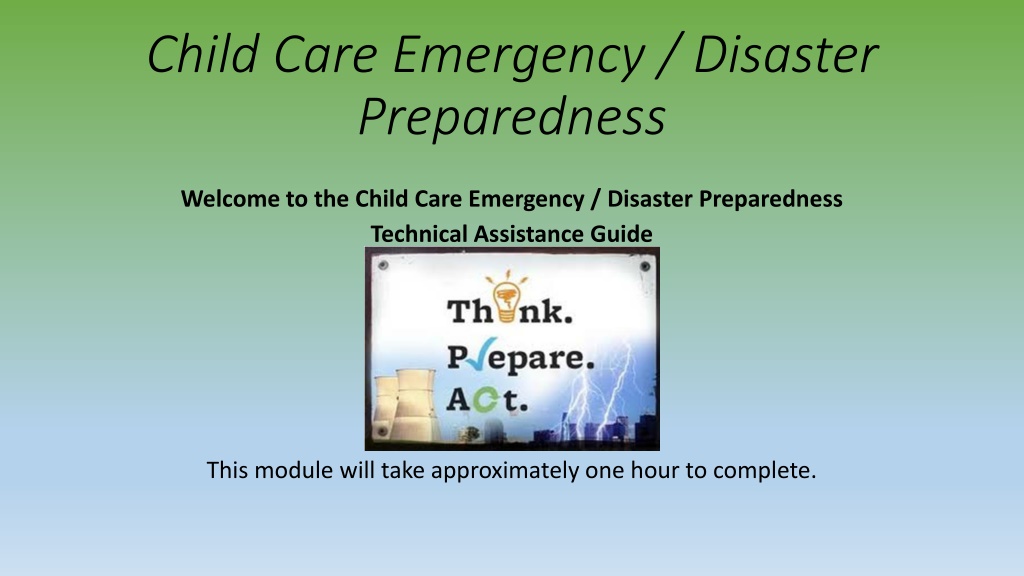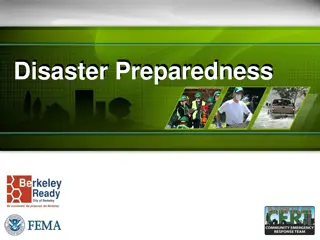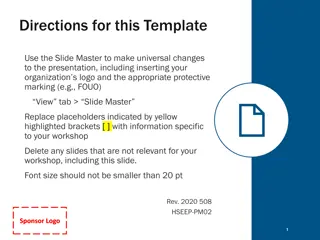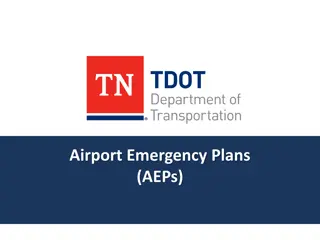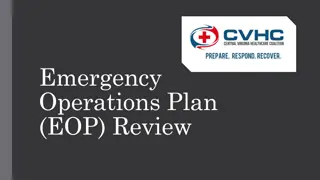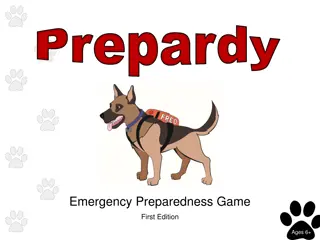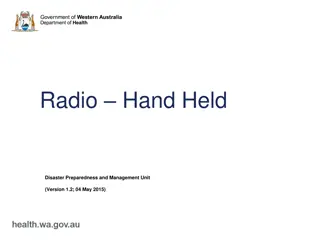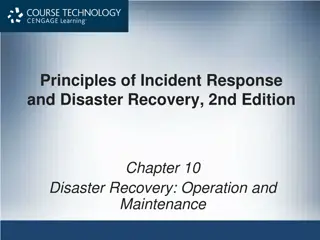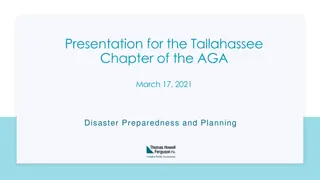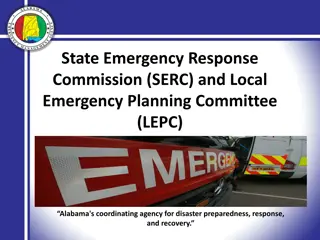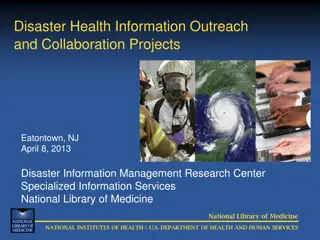Child Care Emergency/Disaster Preparedness Guide
This technical assistance guide provides comprehensive information on emergency and disaster preparedness for child care facilities, covering topics such as evacuation planning, required components, regulations, and resources. It includes multimedia enhancements, sample forms, and helpful links to assist in developing effective emergency plans. The guide is designed to help child care providers create and implement thorough emergency strategies to ensure the safety and well-being of children in their care.
Download Presentation

Please find below an Image/Link to download the presentation.
The content on the website is provided AS IS for your information and personal use only. It may not be sold, licensed, or shared on other websites without obtaining consent from the author. Download presentation by click this link. If you encounter any issues during the download, it is possible that the publisher has removed the file from their server.
E N D
Presentation Transcript
Child Care Emergency / Disaster Preparedness Welcome to the Child Care Emergency / Disaster Preparedness Technical Assistance Guide This module will take approximately one hour to complete.
Introduction There are several multimedia enhancements to this course including PDF files and audio files. You may download many PDF files throughout this course to help you create your Child Care Emergency Plan. You may also click on various text links in order to open PDF files, Word documents or website links. Please be sure you have a sound system adequate for accessing the audio files.
Emergency planning for child caring facilities is a big undertaking and this material Emergency planning for child caring facilities is a big undertaking and this material has been designed to assist you in thinking through the many aspects of designing has been designed to assist you in thinking through the many aspects of designing and implementing your evacuation plan. and implementing your evacuation plan. Sample Child Care Emergency / Disaster Preparedness Planning Forms are available for your use and can be found on the Division of Child Care website. If you choose to develop your own Child Care Emergency / Disaster Preparedness Form, please use this checklist to ensure you have included all the required content needed to meet this regulatory requirement.
Table of Contents Statute and Regulations Why Prepare an Evacuation Plan? Terms to Know Required Components Preparation Response Recovery Notifying the Cabinet Procedures & Evacuation Planning Form Requirements Division of Child Care Suggested Planning Forms Resources
Statute and Regulations We will first cover the Kentucky Revised Statute and Kentucky Administrative Regulations regarding Child Care Emergency Disaster Preparedness and Evacuation Planning.
KRS 199.895 Evacuation Plan Statute The requirements for child-care centers and family child care homes regarding disaster preparedness and emergency planning is outlined in the following state statute: KRS 199.895: An evacuation plan is required for child-care centers and family child care homes - Annual updating of the plan - Provision of plan to local emergency management officials and parents. The following slides will display the statute in full. If you would like a PDF version of this statute, please CLICK HERE.
KRS 199.895 Evacuation Plan Statute (1) A child-care center licensed under KRS 199.896 and a family child-care home certified under KRS 199.8982 shall have a written plan for evacuation in the event of fire, natural disaster, or other threatening situation that may pose a health or safety hazard to the children in the center or home. The plan shall include but not be limited to: (a) A designated relocation site and evacuation route; (b) Procedures for notifying parents of the relocation and ensuring family reunification; (c) Procedures to address the needs of individual children including children with special needs; (d) Instructions relating to the training of staff or the reassignment of staff duties, as appropriate; (e) Coordination with local emergency management officials; and (f) A program to ensure that appropriate staff are familiar with the plan's components.
KRS 199.895 Evacuation Plan Statute (2) A child-care center and a family child-care home shall update the evacuation plan by December 31 each year. (3) A child-care center and a family child-care home shall retain an updated copy of the plan for evacuation, provide an updated copy to appropriate local emergency management officials, and provide a copy to each parent, custodian, or guardian of the child at the time of the child's enrollment in the program and whenever the plan is updated. Effective: July 12, 2012 History: Amended 2012 Ky. Acts ch. 102, sec. 1, effective July 12, 2012. -- Created 2011 Ky. Acts ch. 69, sec. 3, effective December 31, 2011.
922 KAR Evacuation Plan Regulations The Kentucky Administrative Regulations for Child Care requiring components of emergency disaster preparedness planning are: 922 KAR 2:090. Child-care center licensure 922 KAR 2:100. Certification of family child-care homes 922 KAR 2:120. Child-care center health and safety standards 922 KAR 2:180 Requirements for registered child care providers in the Child Care Assistance Program These regulations may be found at: https://apps.legislature.ky.gov/law/kar/TITLE922.HTM
Why Prepare an Emergency / Disaster Evacuation Plan? A Child Care Provider / Facility should prepare plans that allow for partial or full evacuation in a quick and efficient manner. Causes for evacuation may include a natural disaster such as a tornado, earthquake, fire, or flood, or other threats such as an active shooter, structural damage, or building contamination. Support from groups such as Save the Children, the National Commission on Children and Disasters, and the Centers for Disease Control and Prevention also suggest the application of the emergency disaster preparedness requirements to all child care provider types (licensed, certified and registered).
Terms to Know Floor Plans: A map of the facility which shows exits and directional routes to be taken in the event of evacuation. May also include locations of fire extinguishers, first aid kits, safe places within the facility. Lock Down: Occurs as a result of an unsafe situation in the immediate area of the child care facility. This may include armed or dangerous individuals in the area or a hostile individual in the child care facility. Sheltering in Place: Children and staff remain at the facility/home but seek shelter for the emergency / disaster at hand. This would include tornado, chemical releases and lock down. On-site evacuation: Children and staff move out of the facilities affected areas and relocate to another area of the property. Off site evacuation: Children and staff/provider are relocated to designated location not on the property.
Additional Terms to Know Emergency Drill: a pre-arranged event whereby personnel can establish and practice a routine with respect to their role in an emergency. Includes, but is not limited to: Fire Drills held monthly Earthquake and Tornado Drills held quarterly Chemicals Spills/Release Drills Lock-Down Drills Emergency Supply Kit: Supplies to be gathered and stored in an accessible location that will be used during times of emergency/disasters. Additional vocabulary can be researched through FEMA. Click here to view additional Emergency Preparedness Terms.
The Required Components Designing your emergency plan can be broken down into three components: Preparation Response Recovery By breaking the planning process down into these categories, planning won t seem so overwhelming!
Preparation: Save the Children Do the Prep Step! To get your mind in Prep Mode , please view the video to the right from Save the Children. It s a fun way to help you begin to prepare for an emergency. Their 3 steps are as follows: 1. Know your Emergency Contacts 2. Make an Emergency Plan 3. Gather Disaster Supplies These steps can easily be applied to your In- Home Based Child Care or Center-Based Child Care Program to ensure you Get Ready. Get Safe. For additional information, please click here.
Preparation: A Designated Relocation Site & Evacuation Route An effective plan should cover many different scenarios. As you write your plan, try to think about how you might respond to dangers or threats both inside and outside of your facility. The following questions might help you prepare your plan: When is it safer to stay or to go? What is your plan if you have to relocate? Will you be sheltering in place? Will you need to evacuate from your building or home, and seek shelter elsewhere on the property? Will you need to leave the area of your building or home altogether and move to a pre-determined facility in another area of town? The infographic on this page may be a helpful guide for determining when and how to shelter or evacuate. Click on the infographic to the right to be redirected to Child Care Aware of America and enlarge the image.
Preparation: A Designated Relocation Site & Evacuation Route Sheltering in Place Identify the areas of your building or home that will be used during various events: Basement for tornado and windstorms Under heavy furniture for earthquakes Upper level for flooding Know how to shut off your heating and air unit for a chemical incident so that no toxic air is pulled into the building while sheltering in place On Site Evacuation What other areas of your property might be used for an on site evacuation? Examples: Other building on the property. Evacuation Routes MUST be posted! Possibly could be used in Active Shooter incidents, damage to one part of the building while preparing to do an off-site evacuation, etc. Ask yourself what supplies are needed and who will be responsible for making sure they are moved to your shelter location?
Preparation: A Designated Relocation Site & Evacuation Route When Selecting an Off Site Relocation Site: Off Site Relocation Sites One site is required, two (2) are recommended. Written agreement(s) with location(s) is suggested. The agreement(s) with a designated relocation site are to be updated annually. Considerations for relocation site(s): Location/proximity to your current location Size of alternate location Scope of service that can be provided at alternate location Consider Your Zone Hot - a relocation site that is the best match to your needs. Example: Another child care program or church set up for early care and education. Warm a relocation site that is the next best thing to your program. Example: School building with an empty gym and multiple restroom facilities. Cold a relocation site that doesn t meet any of your needs but is a safe place to remain until the all clear is given. Example: A business office with an available meeting space.
Preparation: A Designated Relocation Site & Evacuation Route Questions to help with selecting an Off Site Relocation Site: Are there possible hazards such as railroad tracks, water ways, etc. that may prevent you from evacuating in that direction? How will you transport children and staff? (See Section 12) What supplies are needed and who will be responsible for making sure they are moved to your shelter location? Relocation sites should be planned and shared with staff & families. The nature of the emergency and circumstances of the disaster will be taken into consideration if/when you have to implement an Off Site Evacuation.
Preparation: Procedures for Notifying Parents of the Relocation and Ensuring Family Reunification Name a point person and an alternate to take charge in an emergency. Share the plan with the family, and update annually. Feel free to use the sample reunification plan located here. Bring the Child Information Form with you, along with the child care daily attendance record for pick up and release.
Preparation: Addressing the Needs of Individual Children Including Children with Special Needs Help to prepare children by practicing drills and educating them on the importance of drills. Be aware of supervision needs at all times. Take into consideration staff who are trained in CPR and First Aid. Ensure that needed equipment, medicine, documentation and supplies are taken to the evacuation site. Consider the ages and abilities of each child. For technical assistance regarding the needs of children, call your Child Care Health Consultants (CCHC) at 1-877-281-5277 or visit their website here. More information about supporting special populations.
Preparation: Instructions Relating to the Training of Staff or the Reassignment of Staff Duties as Appropriate Be aware of adequate supervision needs at all times. Providing Adequate Supervision" during an emergency means that qualified staff devotes full-time attention to a child in care and ensures the child is within the scope of vision and range of voice. Take into consideration who is trained in CPR and First Aid and needed first aid supplies. Name a point person in charge and alternate designee/s, assign duties for responding to an emergency/disaster. Actively involve all caregivers in the planning. Fire drills should be conducted during hours of operation at least monthly and documented, detailing the date, time and children who participated. Earthquake and tornado drills shall be conducted during hours of operation at least quarterly and documented, detailing the date, time and children who participated. Click here for a Drill Documentation Sheet. Use this link to locate your county s Child Care Aware Health & Safety Coach for additional technical assistance and for help completing your plan!
Preparation: Coordination with Local Emergency Management Officials Submit a completed copy of your plan, or any updates, to local Emergency Management officials annually. Local Emergency Management contact information for each Kentucky county can be found by clicking this link. Document the contact information for your local agencies and keep it with your emergency supplies that will go with you in the event of enacting your plan.
Preparation: Ensure that Appropriate Staff are Familiar with the Plan s Components Sign and date your Child Care Emergency Disaster Preparedness Plan Form. Send a copy to your local Emergency Management Office and place a copy of your plan in your files to share with child care licensing during your annual survey. Be sure to sign and date your provider statement annually. Sample Provider Statement: I have reviewed the procedures outlined in the Emergency / Disaster Preparedness Plan and ensure that appropriate staff are familiar with the plan s components. These procedures will be followed in case there is an emergency / disaster effecting child care. A sample PDF of this statement can be found here for your use.
Response to an Emergency or Disaster Activate Your Child Care Emergency / Disaster Preparedness Plan. Respond accordingly, taking into consideration the nature of the emergency and circumstance of the disaster. For additional emergency-specific information, see Child Care Aware's Resources to broaden your knowledge of when to activate what plan.
Response: Added Situations to Consider Even if your drills are not Violent Intruder or Active Shooter specific, the procedures should be clear to staff and Local Emergency Management Officials to cover those circumstances. Ensure staff is prepared to implement the plan for every and any scenario that may arise. Remember: when disaster strikes the time to prepare has passed. -Steven Cyros Note: You may click on the graphic to open a link and enlarge.
Recovery from Emergency or Disaster Meet the children s emotional needs. Reassure children after an emergency or disaster. Know the signs of stress after trauma and how to support children who are experiencing stress. Know the Post Disaster Resources that may be available in your area.
Recovery: Notifying the Cabinet With any incident involving fire, notify the cabinet within 24 hours. If facility is damaged and requires temporary or permanent closure, the cabinet and parents of a child enrolled in the facility should be notified as soon as practicable. For an illness or injury or communicable disease, report to cabinet within 24 hours if medical attention is needed. For a major illness or injury report to cabinet within 24 hours. Report death to cabinet within 1 hour. For reporting illnesses and incidents, please call: Division of Regulated Child Care at 502-564-7962, or visit their website by clicking here. If necessary, your Local Emergency Management Official
Emergency / Disaster Procedures & Evacuation Planning Form Requirements A completed Emergency / Disaster Plan should be updated annually. A copy of the plan must be shared with local authorities that may respond to your emergencies. All Child Care providers should be trained in plan procedures and provided clear guidelines to their responsibilities during times of emergency/disaster. When hiring new staff, include training and review of emergency / disaster procedures. All children should be involved in practicing emergency / disaster procedures.
The forms located on this page are samples that you may use or if you prefer, you can design your own forms (with the exception of the Attendance Record for CCAP). If you decide to design your own form, use the Child Care Emergency Planning Checklist to insure you have covered all the regulatory components that are required. Forms and Documents Evacuation Planning Form for Center Based Child Care Emergency/Disaster Preparedness Evacuation Planning Form for Family Child Care Emergency/Disaster Preparedness Things to Know When Preparing for an Emergency and/or Disaster in Child Care Child Care Child Information Form Child Care Daily Attendance Record Child Care Emergency Disaster Preparedness Parent Information Form for Reunification Child Care Evacuation Response Checklist Form Child Care Emergency Disaster Roster Sign-Out Form Child Care Emergency Drill Form Child Care Bomb Threat Information Form Child Care Emergency Planning Checklist Child Care Provider Statement
Resources Resource Links: FEMA - www.fema.gov American Red Cross - www.redcross.org American Academy of Pediatrics - Children and Disasters - Disaster Preparedness to Meet Children's Needs Centers for Disease Control - www.emergency.cdc.gov Centers for Disease Control: Caring for Children - Children in Disasters Department of Homeland Security - www.dhs.gov Department of Homeland Security: Ready Kids - Ready Kids Save the Children - How to Prepare Kids for Emergencies U.S. Department of Health & Human Services - Resource Guide: Emergency Preparedness and Response Resources for Child Care Programs Child Welfare Information Gateway - Disaster Preparedness & Response Federal Fire Safety Administration - www.usfa.fema.gov Division of Child Care, (DCC) - CHFS Division of Child Care Child Care Aware of Kentucky - Child Care Aware
Thank you! We hope you ve gained insight into creating your Emergency/Disaster Preparedness Plan! Again, please reach out to your Health & Safety Coach through Child Care Aware of Kentucky for Technical Assistance relating to development and implementation of your plan! Locate your coach by selecting your county on this webpage! You can also utilize Coach Chat to ask questions to a coach via Facebook Messenger: Click here to be directed to Coach Chat!
